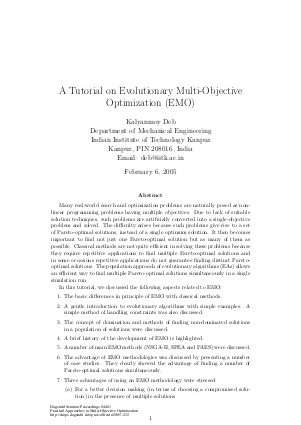A Tutorial on Evolutionary Multi-Objective Optimization (EMO)
Author Kalyanmoy Deb
-
Part of:
Volume:
Dagstuhl Seminar Proceedings, Volume 4461
Part of: Series: Dagstuhl Seminar Proceedings (DagSemProc) - License:
 Creative Commons Attribution 4.0 International license
Creative Commons Attribution 4.0 International license
- Publication Date: 2005-08-10
File

PDF
DagSemProc.04461.5.pdf
- Filesize: 264 kB
- 2 pages
Document Identifiers
Subject Classification
Keywords
- Multi-objective optimization
- multi-criterion optimization
- Pareto-optimal solutions
- Evolutionary methods
- EMO
Metrics
- Access Statistics
-
Total Accesses (updated on a weekly basis)
0Document
0Metadata
Abstract
Many real-world search and optimization problems are naturally posed as non-linear programming problems having multiple objectives. Due to lack of suitable solution techniques, such problems are artificially converted into a single-objective problem and solved. The difficulty arises because such problems give rise to a set of Pareto-optimal solutions, instead of a single optimum solution. It then becomes important to find not just one Pareto-optimal solution but as many of them as possible. Classical methods are not quite efficient in solving these problems because they require repetitive applications to find multiple Pareto-optimal solutions and in some occasions repetitive applications do not guarantee finding distinct Pareto-optimal solutions. The population approach of evolutionary algorithms (EAs) allows an efficient way to find multiple Pareto-optimal solutions simultaneously in a single simulation run. In this tutorial, we discussed the following aspects related to EMO: 1. The basic differences in principle of EMO with classical methods. 2. A gentle introduction to evolutionary algorithms with simple examples. A simple method of handling constraints was also discussed. 3. The concept of domination and methods of finding non-dominated solutions in a population of solutions were discussed. 4. A brief history of the development of EMO is highlighted. 5. A number of main EMO methods (NSGA-II, SPEA and PAES) were discussed. 6. The advantage of EMO methodologies was discussed by presenting a number of case studies. They clearly showed the advantage of finding a number of Pareto-optimal solutions simultaneously. 7. Three advantages of using an EMO methodology were stressed: (i) For a better decision making (in terms of choosing a compromised solution) in the presence of multiple solutions (ii) For finding important relationships among decision variables (useful in design optimization). Some case studies from engineering demonstrated the importance of such studies. (iii) For solving other optimization problems efficiently. For example, in solving genetic programming problems, the so-called `bloating problem of increased program size can be solved by using a second objective of minimizing the size of the programs. 8. A number of salient research topics were highlighted. Some of them are as follows: (i) Development of scalable test problems (ii) Development of computationally fast EMO methods (iii) Performance metrics for evaluating EMO methods (iv) Interactive EMO methodologies (v) Robust multi-objective optimization procedures (vi) Finding knee or other important solutions including partial Pareto-optimal set (vii) Multi-objective scheduling and other optimization problems. It was clear from the discussions that evolutionary search methods offers an alternate means of solving multi-objective optimization problems compared to classical approaches. This is why multi-objective optimization using EAs is getting a growing attention in the recent years. The motivated readers may explore current research issues and other important studies from various texts (Coello et al, 2003; Deb, 2001), conference proceedings (EMO-01 and EMO-03 Proceedings) and numerous research papers (http://www.lania.mx/~ccoello/EMOO/). References: ---------- C. A. C. Coello, D. A. VanVeldhuizen, and G. Lamont. Evolutionary Algorithms for Solving Multi-Objective Problems. Boston, MA: Kluwer Academic Publishers, 2002. K.Deb. Multi-objective optimization using evolutionary algorithms. Chichester, UK: Wiley, 2001. C. Fonseca, P. Fleming, E. Zitzler, K. Deb, and L. Thiele, editors. Proceedings of the Second Evolutionary Multi-Criterion Optimization (EMO-03) Conference (Lecture Notes in Computer Science (LNCS) 2632). Heidelberg: Springer, 2003. E. Zitzler, K. Deb, L. Thiele, C. A. C. Coello, and D. Corne, editors. Proceedings of the First Evolutionary Multi-Criterion Optimization (EMO-01) Conference (Lecture Notes in Computer Science (LNCS) 1993). Heidelberg: Springer, 2001.
Cite As Get BibTex
Kalyanmoy Deb. A Tutorial on Evolutionary Multi-Objective Optimization (EMO). In Practical Approaches to Multi-Objective Optimization. Dagstuhl Seminar Proceedings, Volume 4461, pp. 1-2, Schloss Dagstuhl – Leibniz-Zentrum für Informatik (2005)
https://doi.org/10.4230/DagSemProc.04461.5
BibTex
@InProceedings{deb:DagSemProc.04461.5,
author = {Deb, Kalyanmoy},
title = {{A Tutorial on Evolutionary Multi-Objective Optimization (EMO)}},
booktitle = {Practical Approaches to Multi-Objective Optimization},
pages = {1--2},
series = {Dagstuhl Seminar Proceedings (DagSemProc)},
ISSN = {1862-4405},
year = {2005},
volume = {4461},
editor = {J\"{u}rgen Branke and Kalyanmoy Deb and Kaisa Miettinen and Ralph E. Steuer},
publisher = {Schloss Dagstuhl -- Leibniz-Zentrum f{\"u}r Informatik},
address = {Dagstuhl, Germany},
URL = {https://drops.dagstuhl.de/entities/document/10.4230/DagSemProc.04461.5},
URN = {urn:nbn:de:0030-drops-2520},
doi = {10.4230/DagSemProc.04461.5},
annote = {Keywords: Multi-objective optimization, multi-criterion optimization, Pareto-optimal solutions, Evolutionary methods, EMO}
}
